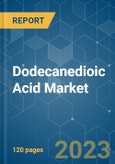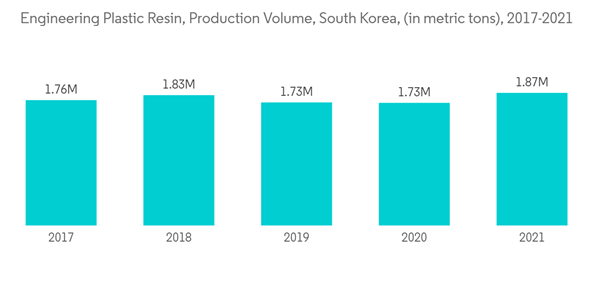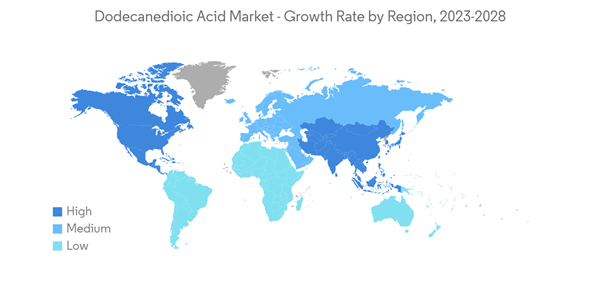The dodecanedioic acid (DDDA) market is expected to register a CAGR of more than 5% during the forecast period. COVID-19 negatively impacted the market in 2020. However, the market is now estimated to reach pre-pandemic levels and is expected to grow steadily.
This product will be delivered within 2 business days.
Key Highlights
- The growing demand for plastic resin in adhesives, automotive, and construction applications is expected to drive market growth.
- However, the hazards related to dodecanedioic acid specified by OSHA will likely hinder the studied market's growth.
- The increasing R&D in bio-based dodecanedioic acid production will likely provide opportunities for the dodecanedioic acid (DDDA) market over the forecasted period.
- Asia Pacific dominated the market globally, increasing consumption from countries like India, China, and Malaysia.
Dodecanedioic Acid (DDDA) Market Trends
High Demand from Plastic Resin Application
- Plastic resins are the dominating segment owing to growing applications in the adhesives, automotive, and construction industries.
- Dodecanedioic acid (DDDA) is used to manufacture different resins, such as epoxy resins, aromatic hydrocarbon resins, phenolic resins, acrylates, lattices, unsaturated polyester resins, specialty resins, and other specialty intermediates. These resins find their usage in different industrial applications.
- The plastic resin demand increased, mainly due to the rising demand for performance plastics from the transportation and construction industry.
- Nylon resin majorly uses dodecanedioic acid in its production. Nylon 6 resins are extensively used as engineering plastics, as they exhibit high stiffness and strength even at elevated temperatures and toughness at low temperatures. Such characteristics result in high fatigue resistance and good welding behavior.
- Nylon 6 resins are increasingly replacing metal in automotive applications, such as air intake manifolds. Their resistance toward oil and greases led to the increased use of engine covers, gears, and bearings.
- Engineering plastic resin is a form of improved thermoplastic used in manufacturing to substitute wood or metal to lower costs while maintaining quality. Statistics Korea shows South Korea produced around 1.87 million metric tonnes of engineering plastic resin in 2021.
- Further, according to Statistics Korea, engineering plastic resin production in South Korea increased by nearly 8% compared to 2020. Thus, expanding engineering plastic resin production is expected to benefit the market's growth significantly.
- Thus, all the above factors are expected to drive the dodecanedioic acid (DDDA) market during the forecast period.
Asia-Pacific to Dominate the Market
- Asia-Pacific is the most significant and fastest-growing region globally due to increasing domestic consumption by economies such as China, India, Malaysia, and Japan. Furthermore, supportive regulations to attract more investments are expected to impact the market positively.
- Asia is one of the largest producers of engineering plastics in the world. China is the largest nylon six resin manufacturer with numerous local international players, like Guangdong Xinhui Meida Nylon Co. Ltd, BASF (China) Co. Ltd, Liheng (Changle) Polyamide Technology Co. Ltd, etc.
- China is the world's largest plastics manufacturer, accounting for approximately one-third of worldwide production, and is expected to drive the market's growth.
- According to the National Bureau of Statistics of China, in 2021, the country produced 80 million metric tonnes of plastic products, a jump of 5.27% over the year before. It is expected to help China maintain its leading global position in plastics production, which will likely generate more demand for dodecanedioic acid.
- Moreover, the region is the largest producer and consumer of paints and coatings, with countries like China, Japan, and India contributing a significant share. The established industrial base is boosting production in the region.
- Furthermore, according to the Japan Plastics Industry Federation (JPIF), Japan's total production of processed plastics products was roughly 5.68 million metric tonnes in 2021. Films and sheets production accounted for most processed plastics in Japan, with more than 2.45 million metric tonnes. It is, thus, boosting the market for Dodecanedioic acid in the region.
- Hence, all such market trends are expected to drive the demand for the region's dodecanedioic acid (DDDA) market during the forecast period.
Dodecanedioic Acid (DDDA) Industry Overview
The global dodecanedioic acid (DDDA) market is consolidated in nature. Some of the major players in the market include Merck KGaA, Chemceed, Cathay Biotech Inc., BASF SE, and UBE Corporation, among others (in no particular order).Additional Benefits:
- The market estimate (ME) sheet in Excel format
- 3 months of analyst support
This product will be delivered within 2 business days.
Table of Contents
1 INTRODUCTION1.1 Study Assumptions
1.2 Scope of the Study
2 RESEARCH METHODOLOGY
3 EXECUTIVE SUMMARY
4 MARKET DYNAMICS
4.1 Drivers
4.1.1 Growing Demand from Resin
4.1.2 Increasing Building and Construction Industry
4.2 Restraints
4.2.1 Hazards Related to Dodecanedioic Acid
4.2.2 Other Restraints
4.3 Industry Value Chain Analysis
4.4 Porter's Five Forces Analysis
4.4.1 Bargaining Power of Suppliers
4.4.2 Bargaining Power of Consumers
4.4.3 Threat of New Entrants
4.4.4 Threat of Substitute Products and Services
4.4.5 Degree of Competition
5 MARKET SEGMENTATION (Market Size in Value)
5.1 By Application
5.1.1 Resin
5.1.2 Powder Coating
5.1.3 Adhesives
5.1.4 Lubricants
5.1.5 Other Applications
5.2 By Geography
5.2.1 Asia Pacific
5.2.1.1 China
5.2.1.2 India
5.2.1.3 Japan
5.2.1.4 South Korea
5.2.1.5 Rest of Asia Pacific
5.2.2 North America
5.2.2.1 United States
5.2.2.2 Canada
5.2.2.3 Mexico
5.2.3 Europe
5.2.3.1 Germany
5.2.3.2 United Kingdom
5.2.3.3 France
5.2.3.4 Italy
5.2.3.5 Rest of Europe
5.2.4 South America
5.2.4.1 Brazil
5.2.4.2 Argentina
5.2.4.3 Rest of South America
5.2.5 Middle-East and Africa
5.2.5.1 Saudi Arabia
5.2.5.2 South Africa
5.2.5.3 Rest of Middle-East and Africa
6 COMPETITIVE LANDSCAPE
6.1 Mergers and Acquisitions, Joint Ventures, Collaborations, and Agreements
6.2 Market Share(%)**/Ranking Analysis
6.3 Strategies Adopted by Leading Players
6.4 Company Profiles
6.4.1 BASF SE
6.4.2 Cathay Biotech Inc.
6.4.3 Chemceed
6.4.4 Selleck Chemicals
6.4.5 Merck KGaA
6.4.6 UBE Corporation
6.4.7 Shandong Guangtong New Materials Co., Ltd.
6.4.8 Santa Cruz Biotechnology, Inc.
6.4.9 TCI Chemicals (India) Pvt. Ltd.
6.4.10 Evonik Industries AG
7 MARKET OPPORTUNITIES AND FUTURE TRENDS
7.1 Increasing R&D in Production of Bio-based Dodecanedioic Acid
Companies Mentioned (Partial List)
A selection of companies mentioned in this report includes, but is not limited to:
- BASF SE
- Cathay Biotech Inc.
- Chemceed
- Selleck Chemicals
- Merck KGaA
- UBE Corporation
- Shandong Guangtong New Materials Co., Ltd.
- Santa Cruz Biotechnology, Inc.
- TCI Chemicals (India) Pvt. Ltd.
- Evonik Industries AG
Methodology

LOADING...










